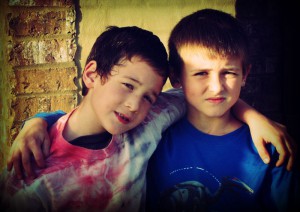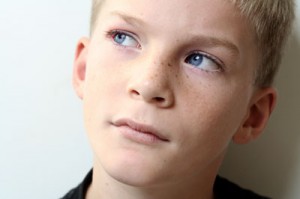 Today I have been seeing families in Bucharest, Romania. This is my second of eight days of seeing children and families here. I arrived in Bucharest after seeing children in Barcelona and London. Between these three cities I will have seen families from many different countries. All of these families have children with developmental issues; all of these families are dedicated to their children; and all of these families are assuming responsibility for their children and their children’s futures. They are all exceptional and can serve as models for parents and families everywhere, not just families of children with issues, but all families.
Today I have been seeing families in Bucharest, Romania. This is my second of eight days of seeing children and families here. I arrived in Bucharest after seeing children in Barcelona and London. Between these three cities I will have seen families from many different countries. All of these families have children with developmental issues; all of these families are dedicated to their children; and all of these families are assuming responsibility for their children and their children’s futures. They are all exceptional and can serve as models for parents and families everywhere, not just families of children with issues, but all families.
In all of my years of travel, seeing children and working with and through families, there is one glaring truth. Wherever the families live, whatever their nationality, whatever their heritage, whatever form of government they live under, whether the family is defined as one parent or two, as only one child or a house full, grandparents or extended family in the home, whatever constitutes the family, they are all united in the care of and dedication to their children and the assumption of responsibility for their children. These families are not looking for their governments to do the job; they rather universally only ask that the government stay out of their way. These are dedicated parents who are absolutely amazingly alike.
In the seventies I was the clinical director of a large United Cerebral Palsy organization. I received grants from the state and federal governments and created model programs and was by most definitions quite successful producing significantly better results than other schools or agencies. But I came to a realization: that whatever I was able to provide for those children within our school and clinics, it was not enough. I also realized that the governments were never going to have the funds to give the children enough, and that expectations were not based on potential, but on the economic realities of what the system could afford to give, and that over time everyone bought into and accepted this distortion of reality and potential. Actually, not everyone–not the families I have been working with all these years. The families who say, “This is my child, this is my son, this is my daughter and I am responsible. I am going to help my child be all they can be. Help me or get out of my way.”
So on this International Day of Families, I am happy to offer up our NACD families from all over the world as models for what families can and should be. All of us at NACD are privileged to be able to know and assist these fantastic families.

 I have spent this week in Barcelona, lecturing on developing cognitive function in children with Down syndrome, seeing some great families, and getting to know this new Barcelona. I traveled here and actually lived here for almost a year back in the seventies. It is incredible how much has changed in forty years. The city has grown tremendously, added a lot of new modern buildings, dramatically resurrected their port area, and really changed the complexion of the city. Since hosting the Olympics in 1992, the city has become much more diverse in its population and has become a favorite of tourists.
I have spent this week in Barcelona, lecturing on developing cognitive function in children with Down syndrome, seeing some great families, and getting to know this new Barcelona. I traveled here and actually lived here for almost a year back in the seventies. It is incredible how much has changed in forty years. The city has grown tremendously, added a lot of new modern buildings, dramatically resurrected their port area, and really changed the complexion of the city. Since hosting the Olympics in 1992, the city has become much more diverse in its population and has become a favorite of tourists. Yesterday I saw one of my favorite moms. She’s a great, dedicated mom who works very hard with her two boys. Her oldest boy has some significant problems, but he keeps progressing and is on most days her “easy” one. His little brother is very bright, doing great, and tends to drive her nuts. Because he is bright and still a little guy, he still does little kid things that get her; and more often than not, they are designed to do exactly that–get her attention. If asked the following questions, her answers would all be “yes”: Is he smart? Yes. Is he a nice kid? Yes. Is he a good kid? Yes. Is he a sweet kid? Yes. Then why should such a child drive her nuts? If he were her best friend’s boy, and not hers, she would love being around him and he wouldn’t drive her to distraction.
Yesterday I saw one of my favorite moms. She’s a great, dedicated mom who works very hard with her two boys. Her oldest boy has some significant problems, but he keeps progressing and is on most days her “easy” one. His little brother is very bright, doing great, and tends to drive her nuts. Because he is bright and still a little guy, he still does little kid things that get her; and more often than not, they are designed to do exactly that–get her attention. If asked the following questions, her answers would all be “yes”: Is he smart? Yes. Is he a nice kid? Yes. Is he a good kid? Yes. Is he a sweet kid? Yes. Then why should such a child drive her nuts? If he were her best friend’s boy, and not hers, she would love being around him and he wouldn’t drive her to distraction. Most days confirm the reality that you really can’t have to many tools in your toolbox. Today I saw a fourteen-year-old “autistic” young man. Zach has been on program for a number of years and has done quite well in most respects. His parents have been quite pleased with his development and changes, particularly the changes that have occurred in the past year and most significantly in the past three months, when the pieces really started coming together at an accelerated rate. Zach has come from being a constantly stimming, DSA (Debilitating Sensory Addiction) out-of-it, unmanageable, difficult, non-communicative child to a boy who goes everywhere with his family, interacts socially, and has become a fun, interactive member of his family.
Most days confirm the reality that you really can’t have to many tools in your toolbox. Today I saw a fourteen-year-old “autistic” young man. Zach has been on program for a number of years and has done quite well in most respects. His parents have been quite pleased with his development and changes, particularly the changes that have occurred in the past year and most significantly in the past three months, when the pieces really started coming together at an accelerated rate. Zach has come from being a constantly stimming, DSA (Debilitating Sensory Addiction) out-of-it, unmanageable, difficult, non-communicative child to a boy who goes everywhere with his family, interacts socially, and has become a fun, interactive member of his family. I finished my day today with a really terrific family. Three months ago I saw their nine-year-old daughter, Mandy, for the first time; today was their first revisit. Mandy’s parents brought her to us because of a plethora of issues, including a full range of academic problems and memory issues, being fearful and distractible, having fine motor, gross motor, and coordination concerns, avoidance behaviors, difficulty with peers, sensitivity to sounds, tics, etc.–a fairly typical mixed bag of issues.
I finished my day today with a really terrific family. Three months ago I saw their nine-year-old daughter, Mandy, for the first time; today was their first revisit. Mandy’s parents brought her to us because of a plethora of issues, including a full range of academic problems and memory issues, being fearful and distractible, having fine motor, gross motor, and coordination concerns, avoidance behaviors, difficulty with peers, sensitivity to sounds, tics, etc.–a fairly typical mixed bag of issues.